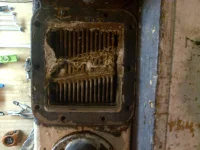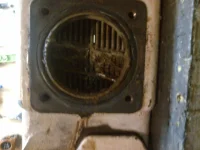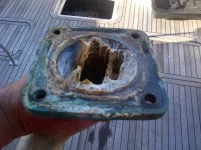brico
Well-known member
- Joined
- Dec 25, 2013
- Messages
- 311
- Status
- OWNER - I own a Hatteras Yacht
- Hatteras Model
- 37' CONVERTIBLE (1977 - 1982)
I've opened up my cooling system. the coolant side looks clean and blockage free. Te coolant color looks pinkish and I'll test it with testing strips tomorrow. The raw water side is a bit of a bummer. The inlet and outlet pipes and flanges have heavy buildup of calcium or whatever that is. I can see the light from both sides and I am sure there is reasonably good flow as my engines never overheated even at WOT load. The heat exchanger core is not bad but it has blockage. While removing the big square inlet flange one of the 10 bolts sheared The one on the bottom) so i decided to remove the whole expansion tank. Easy to remove but is it bloody heavy to take out. I managed alone, but will definitely look for a hand when boxing back.
So how do I remove the heat exchanger core to acid clean it? I see the exit round side/flange can perhaps be "hammered" out and it should exit at the inlet square side. How do I remove it without making damage or do i simply soak the entire expansion tank in DD suggested chemical mixture of Muriatic acid water and oxalic acid? I am afraid what will happen to rubber seals in the process.
In addition, the DD manual talks about 5.5 gallon coolant capacity while I've drained 9.5 gallons after draining it at the pump, bottom of oil cooler, exhaust manifold and block heater. The block heater cavity produced 1 quart or so, the oil cooler 1-1.5 quarts, and exhaust manifold about 2.5 quarts while the rest was from the water pump. total 9.5 gallons. Mine is J&T marinized engine and the expansion tank is certainly J&T one.
So how do I remove the heat exchanger core to acid clean it? I see the exit round side/flange can perhaps be "hammered" out and it should exit at the inlet square side. How do I remove it without making damage or do i simply soak the entire expansion tank in DD suggested chemical mixture of Muriatic acid water and oxalic acid? I am afraid what will happen to rubber seals in the process.
In addition, the DD manual talks about 5.5 gallon coolant capacity while I've drained 9.5 gallons after draining it at the pump, bottom of oil cooler, exhaust manifold and block heater. The block heater cavity produced 1 quart or so, the oil cooler 1-1.5 quarts, and exhaust manifold about 2.5 quarts while the rest was from the water pump. total 9.5 gallons. Mine is J&T marinized engine and the expansion tank is certainly J&T one.




